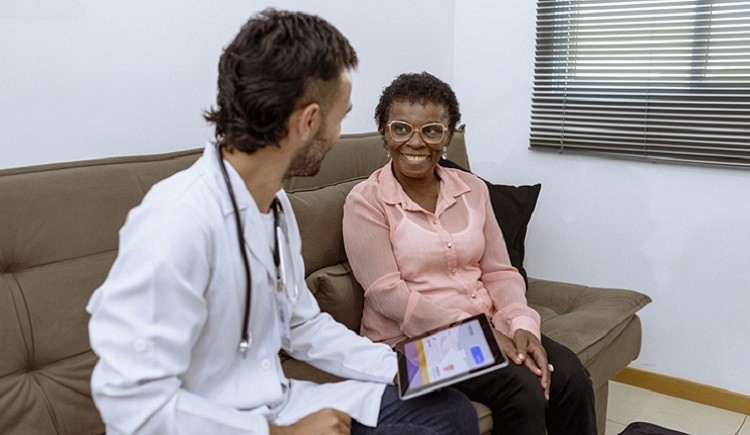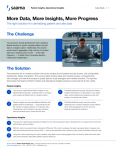dia 2022
Diversity-boosting approach blends trial tech, human element

While low-tech tools like print ads and signs on public transportation frequently are used to try and connect with difficult-to-reach patient populations, they might not be enough to find and recruit those important demographics. According to Ariel Katz, CEO of global healthcare and data analytics specialist H1, the intelligent use of advanced technology can help to bridge the gap.
Recently, Outsourcing-Pharma spoke with Katz about how the right technology and use of data can cut through barriers to reaching and recruiting underrepresented populations in clinical research.
OSP: Could you please share your perspective on how the clinical research field’s attitudes toward and understanding of recruiting sufficiently diverse patient pools have evolved?
It’s heartening to see many stakeholders across the healthcare ecosystem — pharma, academic institutions, med device companies, etc.— starting to make health equity and diversity in clinical trials a top priority. A great example is Pfizer funding a research initiative at Columbia University’s medical center aimed at reducing racial disparities in health by increasing the participation of underrepresented minorities in clinical trials.
We’re also starting to see the use of concrete metrics for diversity and inclusion crop up in research and academic journals. The New England Journal of Medicine now requires its published studies to provide information on how representative trial populations are with respect to broader populations. The FDA is requiring trial sponsors to include information on race, ethnicity, age, and gender of study participants, thereby encouraging researchers to make studies inclusive. These examples reflect a wider trend towards transparency in all aspects of clinical trials, which I’m optimistic about.
OSP: Please talk about some of the efforts we’ve seen undertaken to increase study diversity/inclusion. What has worked, what doesn’t work as well, and how have efforts fallen short?
AK: Some of the most effective strategies for increasing study diversity and inclusion are also the simplest. Decreasing the duration of study visits means people with less time on their hands are more likely to enroll and remain in a study.
Providing trial resources in multiple languages and providing bilingual staff can encourage the participation and retention of people with limited English proficiency. Neighborhood programs and patient advocacy groups can engage with and determine a community’s needs early on, and work to incorporate those needs into the design of upcoming clinical trials.
The use of decentralized (DCT) elements in clinical trials is a mixed bag when it comes to study diversity and inclusion. Telehealth appointments, eConsent and electronic assessments, pulse oximeters, and other tools work well to reduce the number of in-person study visits - thereby removing a key barrier to poorer and more remote populations taking part in trials.
However, there is a digital divide in the US. About 20% of the population does not have access to broadband internet or a smartphone; this rate is higher among older and poorer populations, and among minority ethnic groups. This section of the population may well be less represented in clinical trials as a result of DCT elements.
There are also factors that might seem peripheral to recruiting a diverse group of study participants but are in fact crucial to consider. For example, many patients do not have access to peers who have gone through similar clinical trials or treatments. UPenn has started a clinical trial ambassador program in which new clinical trial patients from minority populations are matched with previous participants to help guide them through the process.
Another important factor is the diversity of the research staff itself. A diverse clinical research faculty can strengthen trust among minority population participants. They also bring different experiences and cultural perspectives to the table.
OSP: Why is it important to keep working toward increased trial diversity, and to solve health disparity problems?
AK: We should all be striving to create a more health-equitable future in which everyone has opportunities to access the latest treatments and best doctors in their pursuit to be as healthy as possible. Increasing trial diversity is critical to achieving that future. Why? People of different ethnicities can have different responses to medicines and treatments, so if a group is underrepresented in a trial, doctors cannot know if a treatment will be effective for them. Furthermore, across marginalized groups, disease profiles can vary considerably, so inclusive trials provide researchers with a more robust and representative picture of symptoms.
In essence, the generalizability of both disease symptoms and appropriate treatments depends on engaging with a diverse patient population, especially in clinical trials. Robust treatment information can lessen health disparities and provide a greater number of people with opportunities to be healthy.
OSP: How can advanced data collection/analysis tools and other technology help?
AK: We are seeing the widespread utilization of real-world data (RWD) and evidence to bolster results from clinical trials. The analysis of hundreds of thousands of patients can inform life science companies on the efficacy and effects of treatments on patient subgroups that may be underrepresented in trials. Today, RWD analytics means using machine learning and predictive modeling, helping to extract insights into drug performance at subpopulation levels.
I’d like to mention a development in clinical trial education here, too. There are now freely available online resources for comprehensive training on minority recruitment and retention in clinical trials. These online courses can help a variety of stakeholders – sponsors, healthcare workers, and patients – stay informed about best practices for increasing diversity in clinical trials.
OSP: What are some key questions and concerns to keep in mind when designing trials and selecting technology in order to maximize DE&I?
AK: In order to maximize DE&I, it’s important to first step back and look for the principal reasons that some groups (women, older patients, Black, Indigenous, Latinx patients, and other People of Color) are often underrepresented in trials. From our research at H1, the FDA’s guidelines, and reviewing academic literature on this subject, there are at least four types of barriers for these groups. Time and resource limitations associated with participating; discomfort with the clinical trial process; lack of trust in the clinical trial and healthcare system; and ignorance of relevant clinical trials taking place.
It is important to keep these barriers front of mind when considering trial design and means of participant recruitment. For example, if one recognizes transportation costs to trial sites as a resource limitation, they can work to ease the travel burdens of a planned visit schedule. This might involve the deployment of mobile medical professionals to visit participants or allowing flexibility in visit windows. To reach a diverse group of people that might be unaware clinical trials are taking place, one might hold recruitment events at nonclinical venues like theaters and barbershops, and on weekends when people have more time.
It is important to consider the many factors that go into increasing inclusivity in trials, and not focus solely on one. A truly diverse group of study participants means diversity in ethnicity, educational levels, gender, socioeconomic class, and so on. It also means diversity across Principal Investigators and sponsors. Trials using decentralized elements like online recruitment campaigns are at risk of selecting for one inclusion factor, such as race, at the expense of other factors, such as education or age.
OSP: You mention your five-year vision for life-science metrics that support greater inclusion—please share your thoughts
AK: Major life sciences companies are making D&I a top priority and have created or are planning to create Health Equity Departments. That is a good start, but diversity must also increase among the leadership team itself. Diversity among healthcare providers has a trickle-down effect and improves the quality of care for underserved populations. In five years, I think having an embedded strategy to improve diversity, an increasingly diverse leadership team, and an established Health Equity Department will be table stakes for pharma companies.
Achieving the diversity we need in clinical trials will also require a comprehensive and actionable data repository that provides accurate and accessible demographic information about physicians and the populations they serve. Having such a data platform in place, with D&I data continually updated, will also be the norm rather than the exception.
OSP: How else can companies like H1 help sites and sponsors in their mission to increase study inclusion?
AK: Using H1’s global data platform, we’ve developed Trial Landscape - an exhaustive clinical trial knowledge base that pulls together global and local registries, comprehensive and up-to-date clinically relevant profiles on trials, people, and sites, and enables analysis around patient segmentation, trial and site performance and investigator profiles. It helps Clinical Operations teams discover a diverse physician and patient populations for trial participation.
H1 can also cross-reference demographic data with claims and referral data, identifying areas with large numbers of underserved racial or ethnic minority patients by doing so. This provides a starting point for identifying healthcare providers who serve those communities.
H1 will be exhibiting in Booth 2354 at the 2022 DIA Global Annual Meeting, scheduled June 19-23 in Chicago. Read here for more information or to register for the event.




















